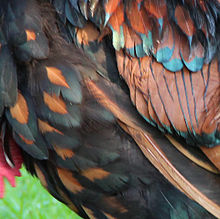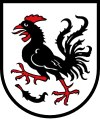Bergischer Kräher
| Bergische Kräher | |||
|---|---|---|---|
|
|||
| Origin: | Germany ( Duchy of Berg ) | ||
| Year: | Documented since the beginning of the 19th century, recognized as a show breed in 1885 | ||
| Colour: | Black and golden brown doubled ( BDRG ) Black and silver doubled (stud book and breeding ring Bergische Kräher) |
||
| Weight: | Rooster: 2.75–3.5 kg. Hen: 2.0–2.5 kg |
||
| Laying output per year: | 120 eggs | ||
| Eggshell color: | White | ||
| Egg weight: | 55 grams | ||
| Breeding standards: | BDRG | ||
| List of breeds of chicken | |||

The Bergisch Kräher or Bergkräher , formerly Kräher over the mountain called, are the oldest German chicken breed belonging to the Langkrähern is expected.
history
Legend has it that the ancestors of the Bergisch crows were introduced from the Balkans in the Middle Ages , where their closest relatives, the Bosnian crows and the Kosovar crows , are still bred today. Molecular genetic studies confirm the relationship between the Bergisches Kräher and Southeast European races. According to another tradition, it was Spanish monks who brought long-crowed chickens into the Bergisches Land .
It is assumed that the Bergische Kräher is the progenitor of the Brazilian crow .
External features
Bergisch crows embody an elongated, erect country fowl shape with a single comb, white ear discs and blue legs . The slightly arched back is characteristic. The drawing of the Bergische Kräher, the Dobbelung , is the strongest form of the feather edging. It occurs only in Bergisch chicken breeds , namely in the crow, the Schlotterkämmen and the Krüpern . Before the breed standard was created, there were three types of color. The only color currently recognized in exhibition is the black and gold brown double ; the black color died out in the 19th century in the absence of formal recognition. The silver-black doubled color occurs occasionally, but is only recognized in the breed standard in Italy.
The crow cry
The main racial feature of the Bergische Kräher is the greatly extended crow call of the roosters, which can last up to 15 seconds. The call of a Bergischer Kräherhahnes consists of four syllables, with a slight extension of the first three and a strong extension of the last. Similar to the Brazilian Singer Chicken , the rooster runs a few steps forward while crowing and lowers its head. Typical of Bergische Kräher is the "Schnork", a snoring sound that occurs when air is drawn in after the call.
In 1904, Vander Snickt, poultry expert and first director of the Düsseldorf Zoo , described the melody as follows:
“Arrives à la note finale, ils prolongent le son en une gamme chromatique ascendante: parvenus à la note la plus élevée, ils redescendent par la même gamme le plus bas possible. »
"When they ( the Bergische Kräher, Red. ) Reach the last crow syllable, they expand the melody in ascending chromatic gradation: when the highest note is reached, they drop over the same steps to the lowest possible range."
Existence and endangerment
Bergisch crows are rare and are considered an endangered domestic animal breed . The BDRG and the GEH have classified the breed in the "Red List of Endangered Livestock Breeds" in hazard class II (highly endangered). After that there were only 77 roosters and 337 hens in Germany in 2009.
The Bergisches Kräher was declared "Endangered Livestock Breed of the Year" by the Society for the Preservation of Old and Endangered Domestic Breeds (GEH) in 2001 together with the Bavarian Landgans , the Bergisch Schlotterkamm and the Krüper .
Special club, stud book and competition crows
Since 1884, the Bergisches Kräher have been looked after by the special association known as the "Kraher breeders' association" . At the same time, in 1916 the "Association of Breeders of Bergisch Chicken Breeds" was established . The two clubs were only merged in 2007. Today's association also looks after the Bergische dwarf crows, the Bergische Schlotterkämme , the Kosovo crows and the Bosnian crows . In 2016 there were around 28 registered breeds. As part of the initiative to preserve old poultry breeds , a stud book was set up in 2015 in the sense of a breeding ring . To maintain the Krährufes the special association organizes annually since 1923 Krähwettbewerbe to Ascension , the Krähruflänge be evaluated and quality in sports competitions.
Bergischer dwarf crow
From 1925 a dwarf breed was bred from the Bergische Krähern. The cock's reputation corresponds to that of the large class. However, Bergische dwarf crows do not call for as long and the call is made in a higher pitch.
heraldry
Since 1936 the city of Haan has had a black, striding mountain crow in its city arms. The heraldic animal symbolizes the fighting spirit of the citizens in a fighting position for the interests of the Lower Mountain homeland.
Black crow as heraldic animal of the city of Haan
Young cock at the crowing competition ( Zülpich , 2015)
Further literature and evidence
literature
- Horst Schmidt and Rudi Proll: Pocket Atlas Chickens and Bantams. Eugen Ulmer Verlag, Stuttgart 2005, ISBN 3-8001-4617-7 .
- Hans-Joachim Schille: Lexicon of the chickens. Komet-Verlag, Cologne 2005, ISBN 3-89836-447-X .
- Walter Schwarz and Armin Six: The large poultry standard in color. 7th edition Oertel + Spörer, Reutlingen 2004, ISBN 978-3-88627-511-3 .
- Armin Six: Bergisch chicken breeds. Oertel + Spörer, Reutlingen 2003, ISBN 978-3-88627-515-1 .
Web links
- Bergische Kräher. Detailed breed description from the Association of Breeders of Bergischer Chicken Breeds
- Bergische Kräher. Breed description of the society for the preservation of old and endangered domestic animal breeds
- Breed boards chickens. (PDF file) Bund Deutscher Rassegeflügelzüchter , p. 13 , accessed on July 31, 2014 (6 MB).
- Breed tables of bantams. (PDF file) Bund Deutscher Rassegeflügelzüchter , p. 14 , accessed on July 31, 2014 (6.8 MB).
- Crowing cock, Bergischer Kräher "Fritz" onYouTube
Footnotes
- ↑ "Bergkräher" is the official name in Switzerland, see the Entente Européenne breed list on www.entente-ee.com
- ↑ August Carl Eduard Baldamus ,: Die Federviehzucht from the economic point of view: chickens, ducks, geese, Salzwasser-Verlag, 2013 (reprint of the original from 1881), p. 81.
- ↑ Louis Vander Snickt wrote "Kroaier ueber den Berg", reference to the Altbergic word for crows
- ^ Schmidt and Proll, p. 24.
- ↑ Bruno Dürigen : Tratado de avicultura, I. Especias y razas. Gustavo Gil, Barcelona 1931, p. 738.
- ↑ Armin Six: Long crane races. Hint-Horoz.de ( Memento from February 6, 2013 in the web archive archive.today )
- ↑ Description of the standard at www.europastandard.com ( Memento of the original from May 14, 2016 in the Internet Archive ) Info: The archive link was inserted automatically and has not yet been checked. Please check the original and archive link according to the instructions and then remove this notice. , accessed May 14, 2016
- ↑ Victor La Perre de Roo, Monographie des races de poules, Paris 1882 , on gallica.bnf.fr, accessed on September 15, 2019
- ↑ List of the chicken breeds recognized in Italy on fiav.info , accessed on March 15, 2019
- ^ Website of the initiative for the conservation of old poultry breeds
- ↑ Der Bergische Kräher und seine Schnork, in: Solinger Tageblatt, September 28, 2014 ( page no longer available , search in web archives ) Info: The link was automatically marked as defective. Please check the link according to the instructions and then remove this notice.
- ↑ Louis vander Snickt: Le chant du coq, in: Bulletin de la Société nationale d'acclimatation de France, 1904
- ↑ Red list of domestic livestock breeds in Germany 2013 ( Memento of the original from February 1, 2014 in the Internet Archive ) Info: The archive link was automatically inserted and not yet checked. Please check the original and archive link according to the instructions and then remove this notice.
- ↑ a b Armin Six: Bergische Kräher - chicken breed with a past (via Waybackmachine from [www.archive.org])
- ↑ Information from the Central Documentation of Animal Genetic Resources of the Federal Office for Agriculture and Food , accessed on May 14, 2019
- ↑ Stud book and breeding ring within the initiative for the preservation of old poultry breeds
- ↑ Reinhard Koll, Haan from the Empire to National Socialism: the garden city between red and brown, Hilden City Archives, Hilden 1994, pp. 22–24








